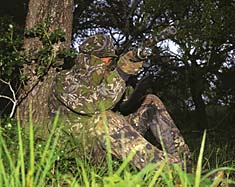|
A Bird In The Brush

By Larry Bozka
Page 2
The drought-damaged countryside that Borries and
I hunted last spring is a far cry from what the place looks like
today. "This is the best range condition scenario that South
Texas has seen in a long time," says the outfitter. "Over
the past eight months, the Brush Country has just gotten greener
and greener. It might make the birds a little more difficult to
spot this season, but it's definitely going to improve the hunting.
With the cover of all that new vegetation, particularly mesquite
leaves, we'll be able to move on the birds a lot better.
"Lush range conditions aside, though, I can't
overemphasize the need to get set up very early," Borries
cautions. "That way, if the birds hear you coming in they
have time to settle back down. Plus, you, too, need time to get
comfortable. Proper positioning is critical, and you have to have
enough time to make sure that you're set up exactly as you should
be."
Calling? "It's certainly important," Borries
says. "But calling is only a fraction of the actual hunt.
If you over-call the birds, they often won't come to you. The
trick is to call just enough to keep them coming."
Borries advises novice turkey callers to start out
with a single-reed diaphragm call. "A single-reed is much
easier to work with, and can still get the job done," he
comments. "Once you become proficient with one, you can move
up to a double-reed or a split-reed. I use a 'Cutter' quite a
bit; you can use it to cluck, purr, cut; you name it. I have more
success with the cutter when hunting Rio Grandes than any other
type of call."
"Why is that?" I ask him.
"I have no idea," Borries replies. "They
just seem to respond to it better; I think it's a 'shock' gobble
more than anything. The main thing to remember," he adds,
"is to stop calling once the bird is on his way. As long
as he's coming your way, stay quiet."
Sunrise was still an hour away when Borries and
I carefully approached the oak motte the following morning. With
the birds already pegged, he skipped the owl hoots and locator
yelps. Instead, we waited.
As the horizon shaded pink through a light, rainy
haze, Borries offered a few "tree yelps" - "just
to get 'em woke up a bit," he later told me - and the birds
responded in kind. One by one, the hens tumbled out of the nearby
trees and sailed virtually over our heads into the small pasture
spread out before us. From there on out, it was textbook turkey
calling.
We heard him a short distance away, and Borries
talked back. The bird gobbled loudly, then spotted the decoys.
I waited a seeming eternity; then a hen stepped out. "He's
right behind her," Borries whispered. Three minutes later,
and a load of copper-plated Winchester No. 4s delivered through
an extra-full turkey choke by a Mossberg 835 3-1/2-inch pump dropped
the bird in his tracks at 30 yards even. I was grateful that the
gun was fitted with a Tru-Glo sight; given the miserable visibility
that morning, the fluorescent sight made sighting in on the bird
about 10 times easier than I anticipated.
He weighed 21 pounds, sported a 10-3/4-inch beard
and had 1-5/16- and 1-3/8-inch spurs - my biggest gobbler to date.
He's currently at taxidermist Joe Lesh's Sportsman Gallery being
transformed into a full-body mount for the Texas Fish & Game¨
office.
(Editor's note: To book a spring turkey hunt with
Doug Borries, call 1-800-THE-HUNT (1-800-843-4868). Or, write:
Dynamic Hunting & Fishing Service, 14812 Glendale Road, Ocean
Springs, MS 39564.)
# # # #
page 1 / page 2
| 
